英语一般现在时
小升初英语语法:一般现在时

16. She _g_o_e_s__ (go) to school from Monday to Friday.
“辅音字母+y”结尾 变y为i, 再加-es,
fly—flies
特殊情况
have→has do→does go→goes
4、实义动词的一般现在时的基本句型
1) 肯定句:
☺主语(I/We/You/They)+实义动词原形+其他 如:I stay at home on Saturdays. They have sports every day.
回顾一
一般现在时的含义
一般现在时表示经常性或习惯性的动作或存在 的状态等。它通常和表示时间状语连用。
例如: Tom goes to school at 7:30 in the morning.
基本用法
1. 表示现在的情况或状态,或者经常性、习 惯性的动作或状态
I wash the dishes every day. You sometimes take a bus home. They usually have lunch at 11:30. He always gets up early. She is often late for school.
I will visit him when I am free. 我有空就去拜访他。 We will have picnic if it doesn't rain tomorrow. 如果明天不下雨,我们就去野餐。 b.表示按规定,计划,时间要发生的动作。 The plane takes off at 11:00. 飞机11点起飞。 c.表示客观性很强的将来。 Today is Wednesday,so tomorrow is Thursday. 今天是星期三,所以明天是星期四。
英语学习:一般现在时语法解释大全
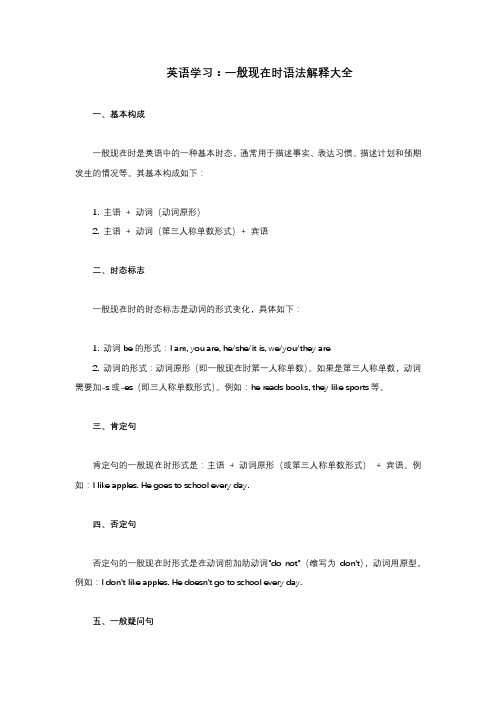
英语学习:一般现在时语法解释大全一、基本构成一般现在时是英语中的一种基本时态,通常用于描述事实、表达习惯、描述计划和预期发生的情况等。
其基本构成如下:1. 主语+ 动词(动词原形)2. 主语+ 动词(第三人称单数形式)+ 宾语二、时态标志一般现在时的时态标志是动词的形式变化,具体如下:1. 动词be的形式:I am, you are, he/she/it is, we/you/they are2. 动词的形式:动词原形(即一般现在时第一人称单数)。
如果是第三人称单数,动词需要加-s或-es(即三人称单数形式)。
例如:he reads books, they like sports等。
三、肯定句肯定句的一般现在时形式是:主语+ 动词原形(或第三人称单数形式)+ 宾语。
例如:I like apples. He goes to school every day.四、否定句否定句的一般现在时形式是在动词前加助动词"do not"(缩写为don't),动词用原型。
例如:I don't like apples. He doesn't go to school every day.五、一般疑问句一般疑问句的一般现在时形式是把助动词"do"或"does"放在句首,动词用原型。
例如:Do you like apples? Does he go to school every day?六、特殊疑问句特殊疑问句的一般现在时形式是以疑问词开头,后面接一般疑问句。
例如:What do you like? Where does he go to school?七、第三人称单数当主语是第三人称单数(he/she/it)时,动词需要变为第三人称单数形式,一般在动词后加-s或-es。
例如:he reads books, she goes to the park等。
一般现在时

一般现在时一般现在时是英语的一种基本时态,它主要用来表示习惯性的动作或状态,其形式是把动词原形中的第三人称单数词素(-s或-es)去掉,加上助动词do(大写),加上noun,再加上in(indicates)。
一般现在时可以分为两类:静态的和动态的。
静态的一般现在时主要用来表示普遍的真理、事实和习惯。
动态的一般现在时主要用来表示经常发生的动作或存在的状态。
在英语中,一般现在时常常使用动词的原形或第三人称单数形式。
具体的形式如下:静态的一般现在时动词原形:I am, you are, he/she/it is, we/you/they are第三人称单数形式:I am, you are, he/she/it is, we/you/they are例如:I am a student. 我是一个学生。
动态的一般现在时现在分词形式:I am doing, you are doing, he/she/it is doing, we/you/they are doing第三人称单数现在分词形式:I am doing, you are doing, he/she/it is doing, we/you/they are doing例如:I am studying English. 我正在学习英语。
一般现在时常常和以下时间状语连用,例如:always, usually, often, sometimes, seldom, rarely, or never.例如:I always go to school by bus. 我总是乘公交车去上学。
除此之外,一般现在时还可以用来表示将来的时间,例如:在时间状语从句或条件状语从句中,当主句为将来时态时,从句可以使用一般现在时表示将来。
例如:If it doesn't rain tomorrow, we will go to the park. 如果明天不下雨,我们会去公园。
英语一般现在时
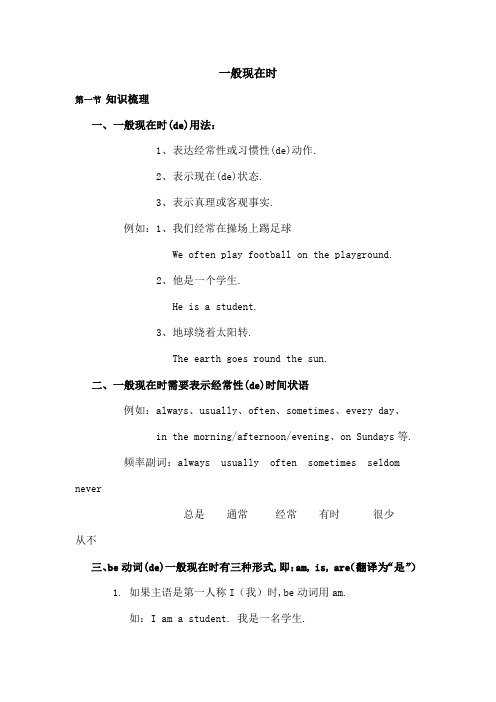
一般现在时第一节知识梳理一、一般现在时(de)用法:1、表达经常性或习惯性(de)动作.2、表示现在(de)状态.3、表示真理或客观事实.例如:1、我们经常在操场上踢足球We often play football on the playground.2、他是一个学生.He is a student.3、地球绕着太阳转.The earth goes round the sun.二、一般现在时需要表示经常性(de)时间状语例如:always、usually、often、sometimes、every day、in the morning/afternoon/evening、on Sundays等.频率副词:always usually often sometimes seldom never总是通常经常有时很少从不三、be动词(de)一般现在时有三种形式,即:am, is, are(翻译为“是”)1. 如果主语是第一人称I(我)时,be动词用am.如:I am a student. 我是一名学生.I am 还可缩写成I'm.如:I'm David. 我是大卫.am 与 not 不能缩写.如:I am not a bad boy.2. 如果主语是you (你,你们), they (他们,它们,她们)或名词复数(两个以上(de)人或物)时,be动词必须用are.如:Are you twelve 你是十二岁吗Tom and Lily are good friends. 汤姆和莉莉是好朋友. They are at school. 他们在学校.are与主语还可缩写.如: We are= We're, They are=They're, You are = You're.而are与 not可缩写成aren't.如:They aren't students. 他们不是学生.3. 如果主语是单数名词、不可数名词或第三人称单数代词(he, she, it)时,be动词用is.如:My mother is a teacher. 我(de)妈妈是一名老师.He is a student. 他是一名学生.is也可与主语缩写,如: He is = He's, My mother is = My mother's等.但是This is不可缩写.而is与not可缩写成 isn't.如:This isn't a book. 这不是一本书.4. 句中含有be动词(de)陈述句变一般疑问句.把be动词提到句首,be动词要变大写.注意第一人称变第二人称.回答时用yes或no表示,结构:Yes, 主语+be动词,No,主语+be动词+not.如:It is a book. 变为:Is it a book5. 句中含有be动词(de)肯定陈述句变否定句.先找肯定陈述句中(de)be动词,在be动词后加not.如:It is a book. 变为: It is not a book.根据以上叙述我们可以把动词(de)用法以口诀(de)形式表述出来:我(I)用am,你(you)用are, is跟着他(he),她(she),它(it);单数名词用is,复数名词全用are.变疑问,往前提,句末问号莫丢弃.变否定,更容易, be后not莫忘记.疑问否定任你变,句首大写莫迟疑.三、There be句型1、There be (de)固定句型:There be + 某物/某人 + 介词 + 某地表示:在某地有某物(或人)2、在there be 句型中,主语是单数,be 动词用is ;主语是复数,be 动词用are ;如有几件物品,be 动词根据最靠近be 动词(de)那个名词决定.3、there be 句型(de)否定句在be 动词后加not , 一般疑问句把be 动词调到句首.4、there be句型与have(has) (de)区别:there be 表示在某地有某物(或人)如:There is a book on the desk.have(has) 表示某人拥有某物如:My father has a car.第二节例题精讲一.选择正确(de)be动词填空1.I ____ a student.2. We ____ friends.3. He ____ a good boy.4. She ____ my sister.5. They ____ my parents.6. You ____ 11 years old.7. I a doctor.8. My father a policeman.9. We having breakfast.10. Tom from Canada.11. Her sister a nurse.12. They my good friends.13. He my brother.14. She ten.15. His mother an actress.二、搭配,连线100% often70-80% always60-70% usually20-50% never10% sometimes0% seldom三、句型转换1、The cat is beautiful.→否定句:→一般疑问句:→肯定/否定回答:2、Her sisters are students.→否定句:→一般疑问句:→肯定/否定回答:四、用“have,has”or “there is , there are”填空1. I________a good father and a good mother.2. ____________a telescope on the desk.3. He_________a tape-recorder.4. _____________a basketball in the playground.5. She__________some dresses.6. They___________a nice garden.7. What do you___________8. ______________a reading-room in the building9. What does Mike___________10. ______________any books in the bookcase11. My father_________a story-book.12. _______________a story-book on the table.13. _______________any flowers in the vase14. How many students____________in the classroom15. My parents___________some nice pictures.16. _____________some maps on the wall.17. ______________a map of the world on the wall.18. David__________a telescope.19. David’s friends___________some tents.20. ______________many children on the hill.第三节巩固练习Be动词一般现在时专项练习(A)一、用be(de)适当形式填空1.---How____ you ---I____ fine.2.I___ David,and my family name___ Green.3.---What color ___ your clock ---It___ white.4.---What___ this in English ---It___ an apple.5.Toy___my brother.David____my brother,too.They ___ my brothers.6.LookThese____apple trees.7.We____ good students and you____ good teacher.8.My sister and my brother_____ students.9._____there many eggs in the kitchen10.____your card number 557811.Where_____ your pencils12.These sweaters ______ fifty dollars.13.How much ____ his jacket14.My brother’s birthday____ December 11th.15.When _____ Kate’s birthday16、There_____a boy and two girls beside the gate.17、Five and three ____ eight.Be动词一般现在时专项练习(B)一、用适当(de)be动词填空1. I a boy. you a boy No, I not.2. The girl Jack’s sister.3. your brother in the classroom4. Who I5. The jeans on the desk.6. There a girl in the room.7. My sister’s name Nancy.8. There some apples on the tree.9. There a boy, two girls, three men and ten women in the park.10. The dog tall an fat.11. The men with big eyes our teacher.12. Where your mother She at home.13. How old your father14. Mike and Bob at school.15. Whose dress this16. Whose socks they17. That my new book.18. There a scarf for you.19. There some bananas for you.20. You, he and I from China.。
小学英语语法时态一般现在时
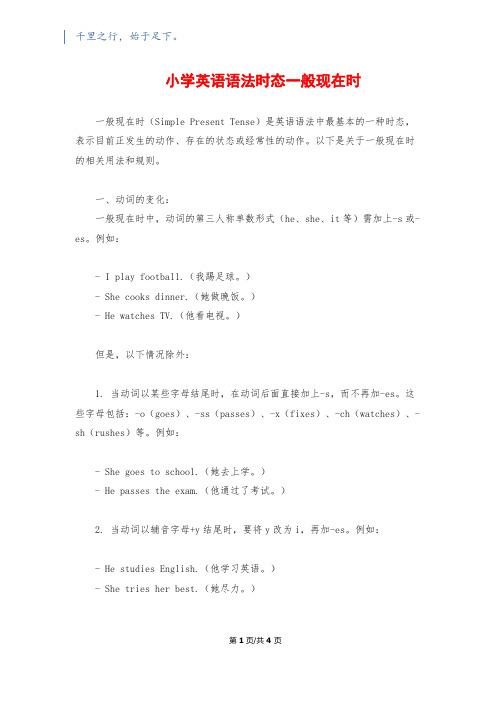
小学英语语法时态一般现在时一般现在时(Simple Present Tense)是英语语法中最基本的一种时态,表示目前正发生的动作、存在的状态或经常性的动作。
以下是关于一般现在时的相关用法和规则。
一、动词的变化:一般现在时中,动词的第三人称单数形式(he、she、it等)需加上-s或-es。
例如:- I play football.(我踢足球。
)- She cooks dinner.(她做晚饭。
)- He watches TV.(他看电视。
)但是,以下情况除外:1. 当动词以某些字母结尾时,在动词后面直接加上-s,而不再加-es。
这些字母包括:-o(goes)、-ss(passes)、-x(fixes)、-ch(watches)、-sh(rushes)等。
例如:- She goes to school.(她去上学。
)- He passes the exam.(他通过了考试。
)2. 当动词以辅音字母+y结尾时,要将y改为i,再加-es。
例如:- He studies English.(他学习英语。
)- She tries her best.(她尽力。
)第1页/共4页3. 当动词以-e结尾时,只需加上-s。
例如:- They write letters.(他们写信。
)- He can dance.(他会跳舞。
)二、用法:1. 描述客观事实或经常性动作:一般现在时常用于描述客观事实或经常性动作。
例如:- Water boils at 100 degrees Celsius.(水沸腾的温度是100摄氏度。
)- I usually go to bed at 10 o'clock.(我通常在10点钟上床睡觉。
)2. 描述现阶段的状态:一般现在时还可用来描述现阶段的状态或对现实情况的评论。
例如:- They live in New York.(他们住在纽约。
)- She looks tired.(她看起来很累。
英语语法解析 一般现在时的构成及用法

英语语法解析一般现在时的构成及用法1.一般现在时的构成:一般现在时主要由动词原形构成。
⑴be动词的第一人称单数形式为am,第三人称单数形式为is,其它人称都用are。
⑵动词have的第三人称单数形式为has。
⑶当主语为第三人称单数时,实义动词后一般需加s或es。
变化规则为:①一般直接加s: visit—visits, care—cares②以s, x, sh, ch,o结尾的动词,后加eswash—washes teach—teaches discuss—discusses go—goes fix—fixes③以辅音字母加y结尾的动词,变y为i再加es。
study—studies worry—worries④一般现在时的疑问句和否定句需要借助助动词do或does(be动词和have除外)He does n't like planting flowers. 他不喜欢种花。
Do you like planting flowers? 你喜欢种花吗?2. 一般现在时的用法⑴表示经常性的,习惯性的动作。
常用的时间状语有:always,usually,every day,often,never,seldom,sometimes等。
He often visits his grandparents on weekends. 他经常在周末去看望他的祖父母。
I take a walk with my husband after dinner every day. 我每天晚饭后和我丈夫散步。
⑵按照时间表,计划表等安排将要发生的动作。
常用于一些表位置移动,往返,出发,到达等含义的动词:come, go, start, begin, arrive, leave, stay等。
The next train leaves at 10:30. 下一班飞机10点半起飞。
The new term begins on September 1. 新学期9月1日开始。
初中英语语法知识之一般现在时
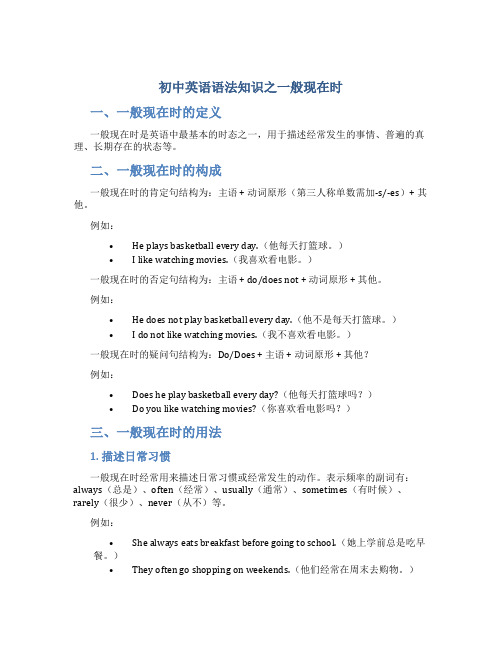
初中英语语法知识之一般现在时一、一般现在时的定义一般现在时是英语中最基本的时态之一,用于描述经常发生的事情、普遍的真理、长期存在的状态等。
二、一般现在时的构成一般现在时的肯定句结构为:主语 + 动词原形(第三人称单数需加-s/-es)+ 其他。
例如:•He plays basketball every day.(他每天打篮球。
)•I like watching movies.(我喜欢看电影。
)一般现在时的否定句结构为:主语 + do/does not + 动词原形 + 其他。
例如:•He does not play basketball every day.(他不是每天打篮球。
)•I do not like watching movies.(我不喜欢看电影。
)一般现在时的疑问句结构为:Do/Does + 主语 + 动词原形 + 其他?例如:•Does he play basketball every day?(他每天打篮球吗?)•Do you like watching movies?(你喜欢看电影吗?)三、一般现在时的用法1. 描述日常习惯一般现在时经常用来描述日常习惯或经常发生的动作。
表示频率的副词有:always(总是)、often(经常)、usually(通常)、sometimes(有时候)、rarely(很少)、never(从不)等。
例如:•She always eats breakfast before going to school.(她上学前总是吃早餐。
)•They often go shopping on weekends.(他们经常在周末去购物。
)2. 表达客观事实或普遍真理一般现在时也被用来表达客观事实或普遍真理。
例如:•The Earth revolves around the sun.(地球绕太阳运行。
)•Water boils at 100 degrees Celsius.(水在100摄氏度沸腾。
英语一般现在时
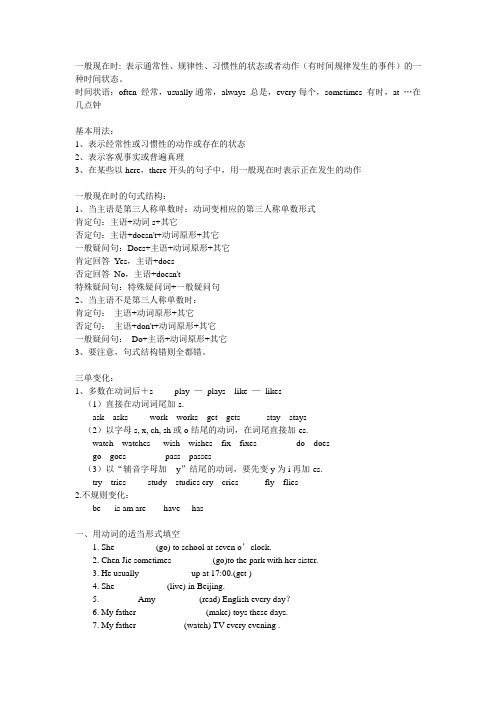
一般现在时: 表示通常性、规律性、习惯性的状态或者动作(有时间规律发生的事件)的一种时间状态。
时间状语:often 经常,usually通常,always 总是,every每个,sometimes 有时,at …在几点钟基本用法:1、表示经常性或习惯性的动作或存在的状态2、表示客观事实或普遍真理3、在某些以here,there开头的句子中,用一般现在时表示正在发生的动作一般现在时的句式结构:1、当主语是第三人称单数时:动词变相应的第三人称单数形式肯定句:主语+动词s+其它否定句:主语+doesn't+动词原形+其它一般疑问句:Does+主语+动词原形+其它肯定回答Yes,主语+does否定回答No,主语+doesn't特殊疑问句:特殊疑问词+一般疑问句2、当主语不是第三人称单数时:肯定句:主语+动词原形+其它否定句:主语+don't+动词原形+其它一般疑问句:Do+主语+动词原形+其它3、要注意,句式结构错则全都错。
三单变化:1、多数在动词后+s play —plays like —likes(1)直接在动词词尾加-s.ask---asks work---works get---gets stay---stays(2)以字母s, x, ch, sh或o结尾的动词,在词尾直接加-es.watch---watches wish---wishes fix---fixes do---doesgo---goes pass---passes(3)以“辅音字母加- y”结尾的动词,要先变y为i再加-es.try---tries study---studies cry---cries fly---flies2.不规则变化:be---- is am are have----has一、用动词的适当形式填空1. She _________(go) to school at seven o’clock.2. Chen Jie sometimes _________(go)to the park with her sister.3. He usually ___________ up at 17:00.(get )4. She ___________ (live) in Beijing.5. ________ Amy _________ (read) English every day?6. My father _______________ (make) toys these days.7. My father __________ (watch) TV every evening .二、选择填空1.I want____homework now.A. doingB. to doC. to do myD. do my2.It's time______.A. go to schoolB. play gamesC. to go homeD. to do my homeworks 3.______go and help her.A. Let's meB. Let's usC. Let'sD. Let's to4.Do they have a new car? Yes,_____.A .they are B.they have C. they don't D. they do5.He often _________ supper at 6:00 in the evening.A. haveB. has c. is having D. is eating6. We _____________ any Chinese classes on Friday.A. are havingB. aren’t havingC. don’t haveD. are have三、用括号内动词的适当形式填空。
英语 一般现在时讲解
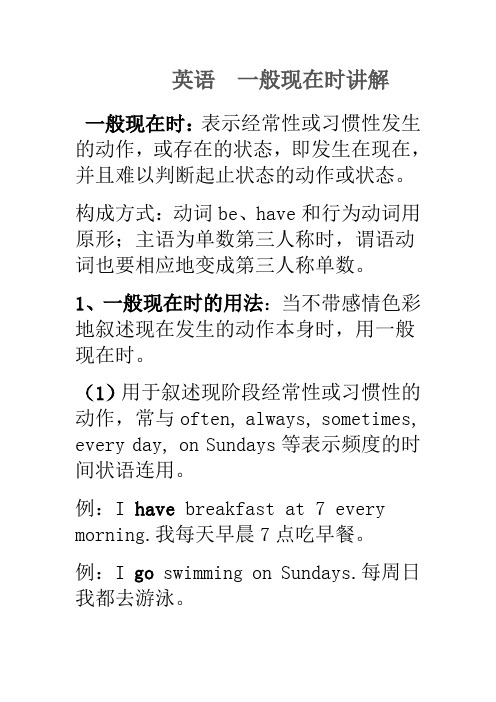
英语一般现在时讲解一般现在时:表示经常性或习惯性发生的动作,或存在的状态,即发生在现在,并且难以判断起止状态的动作或状态。
构成方式:动词be、have和行为动词用原形;主语为单数第三人称时,谓语动词也要相应地变成第三人称单数。
1、一般现在时的用法:当不带感情色彩地叙述现在发生的动作本身时,用一般现在时。
(1)用于叙述现阶段经常性或习惯性的动作,常与often, always, sometimes, every day, on Sundays等表示频度的时间状语连用。
例:I have breakfast at 7 every morning.我每天早晨7点吃早餐。
例:I go swimming on Sundays.每周日我都去游泳。
(2)表示现阶段存在的状态、特征或心理活动。
例: I like fruits.我喜欢水果。
(3)用于叙述客观事实或真理。
例:The Thames flows through London.泰晤士河穿过伦敦。
例:The sun rises in the east and sets in the west.太阳东升西落。
(4)表示主语具备的性格、能力和特征。
例:They speak English very well.他们英语说得很好。
例:This taxi driver knows the city of Beijing like the back of his hand.这位出租司机对北京城了如指掌。
(5)表示计划安排好的将来动作,也可用一般现在时,但只限于:go, come, leave, start, begin, arrive, be等动词。
例:The plane takes off at 11 a.m.飞机上午11点起飞。
例:We leave Beijing next month.我们下月离开北京。
例:He comes back tonight.他今晚回来。
(6)在时间、条件状语从句中,用一般现在时代替一般将来时。
初中英语知识点总结一般现在时
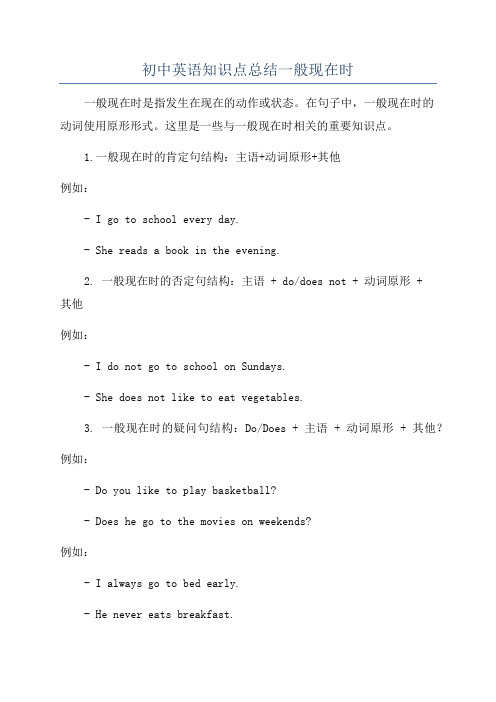
初中英语知识点总结一般现在时一般现在时是指发生在现在的动作或状态。
在句子中,一般现在时的动词使用原形形式。
这里是一些与一般现在时相关的重要知识点。
1.一般现在时的肯定句结构:主语+动词原形+其他例如:- I go to school every day.- She reads a book in the evening.2. 一般现在时的否定句结构:主语 + do/does not + 动词原形 +其他例如:- I do not go to school on Sundays.- She does not like to eat vegetables.3. 一般现在时的疑问句结构:Do/Does + 主语 + 动词原形 + 其他?例如:- Do you like to play basketball?- Does he go to the movies on weekends?例如:- I always go to bed early.- He never eats breakfast.5. 表示客观真理、规律或常识时,一般现在时可用于所有人称,不需要使用助动词do/does。
例如:- The sun rises in the east.- Water boils at 100 degrees Celsius.6. 当主语为第三人称单数时,动词需要变化。
一般情况下,加上-s 或-es。
例如:- She eats lunch at 12 o'clock.- The dog barks loudly.7.部分动词在第三人称单数时需要做变化- go→goes- do→does- have→has例如:- He goes to school by bus.- She does her homework every day.- My mother has a pet cat.8. 当主语为we, they, you或复数名词时,动词不需要做变化。
初中英语语法知识之一般现在时

初中英语语法知识之一般现在时有很多同学分不清时态,时态是一篇文章的主线,如果时态都分不清那我们就分不清事情发生的先后,会对我们做题设障碍,所以今天小编为大家整理了一些时态上的知识,希望能帮到大家。
一般现在时表示现在经常反复发生的动作、存在的状态或习惯性的动作的时态。
一、一般现在时用法如下:1.表示现在的状态: e.g. He’s twelve. She’s at work.2.表经常或习惯性的动作,常与表示频度的时间状语连用。
: eg. I get up at 6:30 every day.He reads English every morning.3.表主语具备的性格、能力和特征。
e.g. I don't like this book.4.表示客观事实和普遍真理。
The earth moves around the sun.5. 在时间状语从句和条件状语从句中,常用一般现在时代替将来时。
eg. I'll write to you as soon as I arrive there.二、一般现在时构成:一般现在时用行为动词的原形,但第三人称单数作主语时,动词要用第三人称单数形式。
第三人称单数形式的变化规则是:1.一般的动词词尾+S。
2.以sh/ch/s/x 结尾的词+es.3.以辅音字母+Y 结尾的把 Y 变成 i,+es。
4.辅音字母+o 结尾的+es.基本结构:1.be 动词肯定句:主语+be(am,is,are)+其它。
如: I am a boy.我是一个男孩。
否定句:主语+ be + not +其它。
如:He is not a worker.他不是工人。
一般疑问句:Be +主语+其它。
如:-Are you a student? -Yes. I am. / No, I'm not.特殊疑问句:疑问词+一般疑问句。
如:Where is my bike?2.行为动词1) 当主语为第一,二人称及复数时,助动词为 do肯定句:主语+动词原形(+其它)。
英语语法:一般现在时

rarely
sometimes
often
usually
always
3、次数
一次 once 两次 twice 三次 three times 一周两次 twice a week 每周四次 four times a week 每周六 on Saturdays 每周日 on Sundays
含be一般疑问句的改写
• 秘诀:一调二改三问号
一调:即把句中的be调到主语前;
二改:改换主语称谓,即将句中的主语 I my mine we our ours 等第一人称分别改为相应的第 二人称you your yours等;
三问号:句末的句号改为问号
C. 特殊疑问句: 特殊疑问词+be(am, is, are)+主语+其他?
film dance music dance film comput music er
music compu compute film ter r
dance music film
1. Mary _______ dances. 2. Mary _______ listens to music. 3. Mary _______ goes fishing. 4. Mary _______ plays basketball. 5. Mary _______ plays computer . 6. Mary _______ watches a film.
一般现在时
一般现在时(关键词)
现在 经常反复发生 习惯性 规律、真理
(一)一般现在时的概念
1. 表示目前的情况或状态。 【eg】We’re at school. 我们在上学。 2. 表示主语所具备的性格、特征或能力。 【eg】 They speak English. 他们说英语。 3. 表示现阶段经常性或习惯性的动作。 【eg】The girl goes to school by bike every day. 这个女孩每天骑自行车去上学。
小学英语语法_一般现在时详细讲解

千里之行,始于足下。
学校英语语法_一般现在时具体讲解一般现在时(Simple Present Tense)是英语中最基本的时态之一,用来表达经常性或习惯性的动作、客观事实、常规活动等。
以下是一般现在时的具体讲解。
1. 构成:主语 + 动词原形(第三人称单数要在动词后加-s)+ 其他。
例如:- I play soccer on weekends.(我周末踢足球。
)- He watches TV every evening.(他每天晚上看电视。
)2. 主语:一般现在时的主语可以是第一人称、其次人称或第三人称。
例如:- I go to school every day.(我每天去上学。
)- You like ice cream.(你宠爱冰淇淋。
)- She plays the piano well.(她弹得很好。
)3. 动词的变化:- 第三人称单数一般在动词后面加上-s或-es。
例如:he/she/itplays(he plays,she plays,it plays),he/she/it watches(he watches,she watches,it watches)。
- 一般现在时的否定形式是在动词前面加上do not(don’t)或does not(doesn’t)。
例如:I do not dance(我不跳舞),She does not like coffee(她不宠爱咖啡)。
- 一般现在时的疑问形式是把do或does放在主语前面。
例如:Do you play tennis?(你打网球吗?),Does she go to the gym?(她去健身房吗?)4. 使用场景:第1页/共2页锲而不舍,金石可镂。
- 表达经常性或习惯性的动作。
例如:I eat breakfast every morning.(我每天早上吃早餐。
)- 表达客观事实、普遍真理等。
例如:The sun rises in the east.(太阳从东方升起。
小学英语语法知识点总结:一般现在时

★这篇《⼩学英语语法知识点总结:⼀般现在时》是⽆忧考为⼤家收集的,以下内容仅供参考!⼀般现在时的功能 1.表⽰事物或⼈物的特征、状态。
如:The sky is blue.天空是蓝⾊的。
2.表⽰经常性或习惯性的动作。
如:I get up at six every day.我每天六点起床。
3.表⽰客观现实。
如:The earth goes around the sun.地球绕着太阳转。
⼀般现在时的构成 1. be动词:主语+be(am,is,are)+其它。
如:I am a boy.我是⼀个男孩。
2.⾏为动词:主语+⾏为动词(+其它)。
如: We study English.我们学习英语。
当主语为第三⼈称单数(he, she,it)时,要在动词后加"-s"或"-es"。
如:Mary likes Chinese.玛丽喜欢汉语。
⼀般现在时的变化 1. be动词的变化。
否定句:主语+ be + not +其它。
如:He is not a worker.他不是⼯⼈。
⼀般疑问句:Be +主语+其它。
如:-Are you a student? -Yes. I am. / No, I'm not. 特殊疑问句:疑问词+⼀般疑问句。
如:Where is my bike? 2.⾏为动词的变化。
否定句:主语+ don't( doesn't ) +动词原形(+其它)。
如: I don't like bread. 当主语为第三⼈称单数时,要⽤doesn't构成否定句。
如: He doesn't often play. ⼀般疑问句:Do( Does ) +主语+动词原形+其它。
如: - Do you often play football? - Yes, I do. / No, I don't. 当主语为第三⼈称单数时,要⽤does构成⼀般疑问句。
英语一般现在时的知识点归纳

英语一般现在时的知识点归纳
一、现在时的概念
现在时表示现在发生的动作或存在的状态,也可以表示经常性或习惯性的动作。
二、现在时的时态
1. 一般现在时:表示经常性或习惯性的动作,常用动词的一般形式,如:He works in a factory.
2. 现在进行时:表示正在进行的动作,常用动词的现在分词形式,如:He is working in the factory.
3. 现在完成时:表示过去发生的动作对现在造成的影响,常用助动词have/has + 动词的过去分词形式,如:He has finished his work.
三、现在时的用法
1. 表示现在的状态:
He lives in Beijing.
2. 表示客观真理:
The earth goes round the sun.
3. 表示现在的计划、安排:
I'm leaving for Shanghai tomorrow.
4. 表示经常性或习惯性的动作:He often goes shopping on weekends.。
英语语法一般现在时

英语语法一般现在时一般现在时(The Simple Present Tense)是我们英语学习中接触到的第一个时态,也是初一英语最重要的语法内容之一。
和老师全方位学习一下吧!一. 一般现在时有三种形式1. 谓语是be(am/is/are)的一般现在时。
①肯定形式:主语+be+表语(形容词、名词充当表语)。
I am hungry.You are beautiful.He is a doctor.②否定形式:主语+be+not+表语(形容词、名词充当表语)。
I am not hungry.You aren't beautiful.He isn't a doctor.③一般疑问句形式:Be+主语+表语(形容词、名词充当表语)?肯定回答:Yes,主语+be. 否定回答:No, 主语+ be+not.—Are you hungry?—Yes,I am./No,I'm not.—Is he a doctor?—Yes, he is./No, he isn,t.④特殊疑问句形式:特殊疑问词+Be开头的一般疑问句?—What is he?—He is a doctor.注意:be要随着主语变。
2. 谓语动词是实义动词(及物动词或不及物动词)的一般现在时。
①肯定形式:“主语+及物动词+宾语”或“主语+不及物动词”。
She has a little brother.她有一个弟弟。
The sun rises in the east.太阳从东方升起。
②否定形式:“主语+don't/doesn't+及物动词+宾语”或“主语+don't/doesn't+不及物动词”。
She doesn't have a little brother.她没有弟弟。
I don't eat every morning.我每天早晨都不吃饭。
③一般疑问句形式:“Do/Does+主语+及物动词原形+宾语”或“Do/Does+主语+不及物动词原形”。
中考英语《一般现在时》知识点:一般现在时态
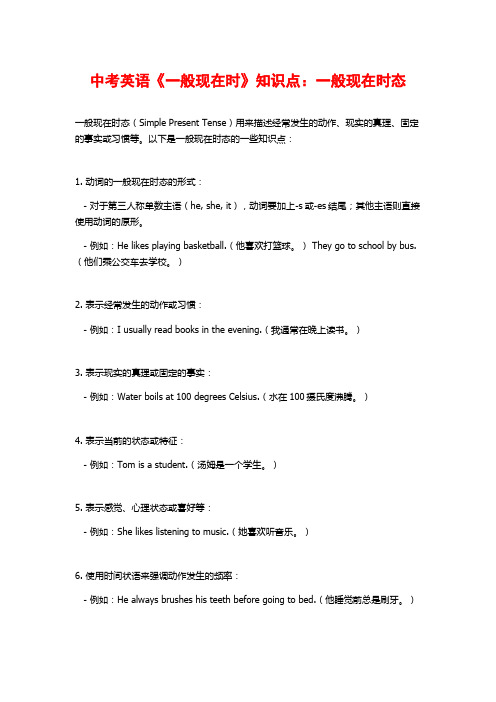
中考英语《一般现在时》知识点:一般现在时态一般现在时态(Simple Present Tense)用来描述经常发生的动作、现实的真理、固定的事实或习惯等。
以下是一般现在时态的一些知识点:1. 动词的一般现在时态的形式:- 对于第三人称单数主语(he, she, it),动词要加上-s或-es结尾;其他主语则直接使用动词的原形。
- 例如:He likes playing basketball.(他喜欢打篮球。
) They go to school by bus.(他们乘公交车去学校。
)2. 表示经常发生的动作或习惯:- 例如:I usually read books in the evening.(我通常在晚上读书。
)3. 表示现实的真理或固定的事实:- 例如:Water boils at 100 degrees Celsius.(水在100摄氏度沸腾。
)4. 表示当前的状态或特征:- 例如:Tom is a student.(汤姆是一个学生。
)5. 表示感觉、心理状态或喜好等:- 例如:She likes listening to music.(她喜欢听音乐。
)6. 使用时间状语来强调动作发生的频率:- 例如:He always brushes his teeth before going to bed.(他睡觉前总是刷牙。
)需要注意的是,一般现在时态还可以用来表示将来安排好的事情,但需要配合适当的时间状语来使用。
例如:We have a meeting tomorrow.(我们明天有一个会议。
)但在这种情况下,一般现在时态通常会与表示将来的时间短语一起使用,比如tomorrow(明天)、next week(下周)等。
英语最基本的五个时态
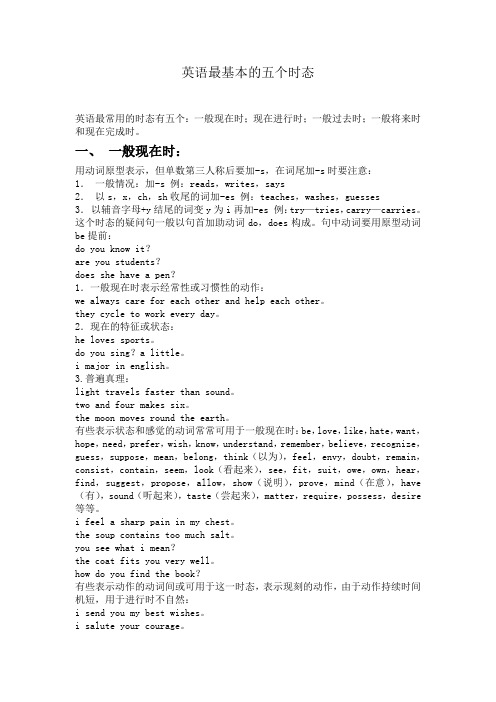
英语最基本的五个时态英语最常用的时态有五个:一般现在时;现在进行时;一般过去时;一般将来时和现在完成时。
一、一般现在时:用动词原型表示,但单数第三人称后要加-s,在词尾加-s时要注意:1.一般情况:加-s 例:reads,writes,says2.以s,x,ch,sh收尾的词加-es 例:teaches,washes,guesses3.以辅音字母+y结尾的词变y为i再加-es 例:try—tries,carry—carries。
这个时态的疑问句一般以句首加助动词do,does构成。
句中动词要用原型动词be提前:do you know it?are you students?does she have a pen?1.一般现在时表示经常性或习惯性的动作:we always care for each other and help each other。
they cycle to work every day。
2.现在的特征或状态:he loves sports。
do you sing?a little。
i major in english。
3.普遍真理:light travels faster than sound。
two and four makes six。
the moon moves round the earth。
有些表示状态和感觉的动词常常可用于一般现在时:be,love,like,hate,want,hope,need,prefer,wish,know,understand,remember,believe,recognize,guess,suppose,mean,belong,think(以为),feel,envy,doubt,remain,consist,contain,seem,look(看起来),see,fit,suit,owe,own,hear,find,suggest,propose,allow,show(说明),prove,mind(在意),have (有),sound(听起来),taste(尝起来),matter,require,possess,desire 等等。
- 1、下载文档前请自行甄别文档内容的完整性,平台不提供额外的编辑、内容补充、找答案等附加服务。
- 2、"仅部分预览"的文档,不可在线预览部分如存在完整性等问题,可反馈申请退款(可完整预览的文档不适用该条件!)。
- 3、如文档侵犯您的权益,请联系客服反馈,我们会尽快为您处理(人工客服工作时间:9:00-18:30)。
英语一般现在时 Prepared on 22 November 2020
一般现在时态定义及变化规则
例句: I am a teacher,
为:I am not a teacher
一般现在时泛用于习惯性动作,加,单三加s或es,以o/s/sh/ch/x结尾加es
的一般现在时如果句子的动词不是be 动词 "am is are" 而是其他实义动词,和否定句要借助于助动词"do"或者 "does",也就是说be 动词和实义动词原形不能同时使用。
这里的 "do","does" 本身没有什么意义,只是帮助构成疑问句和."do"和 "does"的使用要随着人称的变化而变化。
请看下面两组句子,注意区分他们的共同点和不同点。
肯定句:I go to school every day.
否定句:I don't go to school every day.
单三形式肯定句:He goes to school every day. 否定句:He doesn't go to school every day.
Do you go to school every day -----------Does he go to school every day
Yes, I do. (No, I don't) --------------Yes, he does. (No, he doesn't)
当是第三人称单数时
为:主语+动词的s形式+宾语
为:主语+doesn't++宾语为:Does+主语+动词原形+宾语
肯定回答和否定回答也要使用助动词does.
注:第三人称用了 does 后面就不用动词的s形式了,而用动词原形.
动词的一般现在时态, 除了第三人称单数(he she it) 外,其余都用动词原形。
当主语是其他人称时
肯定句为:主语+动词原形+宾语
否定句为:主语+助动词don't+动词原形+宾语
疑问句为:Do+主语+动词原形+宾语
肯定回答和否定回答也要使用助动词do.
注:变为疑问句,要在句首加"do" ; 变为否定句, 要在动词前面加"do not", 可以简写为 "don't".
构成
现在进行时的构成是:主语+be动词(am /is /are)+动词ing形式〔现在分词〕
:主语+be动词(am /is /are)+动词ing+其他。
:主语+be动词(am /is /are)+not+动词ing+其他。
:Be动词+主语+动词ing+其他。
:+一般疑问句
肯定回答:Yes,主语+be动词(am /is /are)。
否定回答:No,主语+be动词(am /is /are)+not。
注:is not可以缩写成isn‘t,are not可以缩写成aren’t,但是am not在现代英语中不可以缩写——古英语及诗歌中am not缩写成ain‘t。
变化规则
时间状语
可用来表示现在进行时的,常用的有:now,this week,at the moment,right now 等;或者告诉你一个准确的现在时间,或者用look,listen(常用于句子的开头,表示提醒听者注意正在发生的事情)。
例如:
◇They are playing basketball now.
现在,他们正在打篮球。
◇Listen, She is singing an English song.
听,她正在唱英文歌。
◇Look at the picture. The children are flying kites in the park.
看这幅图。
那些孩子正在公园放风筝。
◇We are making model planes these days.
这些天我们在做飞机模型。
◇It's 6:30 now. I am getting up.
现在是6:30,我正在起床。
句型分析
1、是将be移到主语前面,句末加问号,读升调。
be+主语+doing sth
◇Are they putting up the scaffolding Yes, they are. / No, they aren't.
◇Is he showing a foreign guest round the city Yes, he is. / No, he isn't.
2、式是在be动词后加not。
主语+be+not+doing sth
◇I am not working.
◇He isn't runnig or the track.
◇The students aren't playing football.
使用场合
1、当句中出现的表示时间的词是now,at the moment,;(此刻、现在)等时,表示句子要说明的是现在正在发生的事,动词应用现在进行时。
◇Linda's brother is watching TV in his bedroom now.
现在,琳达的哥哥正在他的卧室里看电视。
◇We're far from home. What are our parents doing at the moment
现在,我们远离家了,我们的父母此刻在干什么呢
2、当句中出现的时间状语是these days,this week,this month,this term 等时,如果句子所要表达的意义是在这一阶段正在发生的事,则动词应用现在进行时。
◇These days we are helping the farmers work on the farm.
这些天我们在农场帮农民们干活。
◇They're having a test this week.
这一周,他们在进行一次考试。
◇Mr Cheng is visiting our village this month.
这个月,程先生在我们村访问。
3、在句中出现了Look,Listen,Can't you see 等暗示词时,说明后面的动作正在发生,该动词应用现在进行时。
◇Look! Maria and Tom are dancing under the tree.
看!玛丽亚和汤姆正在树下跳舞。
◇Listen! Our English teacher is singing the popular English song.
听!我们英语老师正在唱那首流行的英文歌曲。
◇Many children are swimming in the river. Can't you see
许多小孩在河里游泳,你难道看不见吗
4、注意根据上下文的暗示,句子的谓语动词可能应用现在进行时。
◇— Where is Mr Wang
—王先生在哪儿
◇— Oh, he is reading a newspaper in the office.
—噢,他正在办公室看报。
(问句询问王先生在哪儿,应说明他现在在哪儿,故答句应说明他现在正在做的事,用现在进行时。
)
◇—Is that boy Jack
—那个男孩是杰克吗
◇— No,Jack is doing his homework in the classroom.
—不是,杰克正在教室做作业呢。
(答句中说明的杰克做作业的情况应发生在现在,应用现在进行时。
)
5、现在进行时态表将来,主要用于表示按计划或安排要发生的动作。
常有“意图”“决定”的意思
◇They’re getting married next month.
他们下个月结婚。
